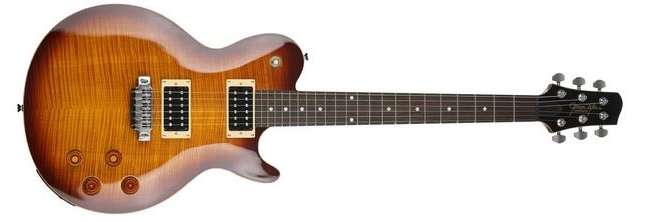
Review by Andrew Weaver
Line 6’s JTV59 Variax guitar is a versatile and unique instrument that provides an excellent bang-for-the-buck. Although introduced over ten years ago, the JTV59 is still readily available both new (around $1200) and used ($800-$1000), and remains an interesting solution for players needing a variety of classic guitar tones. At first glance, the JTV59 is a quality Les Paul copy with a mahogany body, maple top, and 2 custom James Tyler humbuckers. As a Les Paul copy, it performs admirably, although there are certainly other options in this price range. The real draw here is the hex piezo pickup in the bridge that allows the guitar to model a variety of electric and acoustic guitars (along with some other stringed guitar adjacent instruments, and a variety of alternate tunings for each). If you’re familiar with Line 6 as a company, you know that modeling famous tones of the past has been their bread and butter for decades. Line 6’s famous POD amp modeler, along with a variety of amps, stomboxes, and software solutions from the company have allowed bedroom producers/guitarists and professionals to tap into surprisingly realistic and lifelike modeled tones for years. The original Variax was their first stab at modeling physical guitar models, and this second version finds them refining the concept. If you have experience with Line 6’s amps/software/POD..etc, you have an idea of what to expect tone/quality wise from the JTV59. That is to say, it is a fantastic piece of equipment, but it does have its limitations. I’ll dive a little deeper into things with Pros/Cons of the JTV59 from the perspective of a musician focusing on music for production music libraries/TV/film/visual content.
PROS:
The main draw here is obviously the amount of tones you have access to for a reasonable cost. Whether you need a screaming Les Paul solo, a delicate acoustic passage, or a twangy Tele for a country cue, you’re covered quite well with this guitar. Some models fare better than others under intense scrutiny, but most hold up quite well. The other big draw here for production music producers is the speed that this guitar allows you to lay down a variety of guitar tracks. If you need an acoustic rhythm guitar, a clean Strat style guitar playing arpeggios, and a lead line from a Les Paul, you can lay all these tracks down without even unplugging your guitar (let alone setting up mics for the acoustics). It’s a huge time saver and although this might not be a draw to purists or producers that only need one guitar tone, if you need to lay down quality tracks at a high quantity, this guitar is absolutely an asset. Another pro worth mentioning is the rechargeable battery. The battery charges quickly and provides at least 12 hrs of play on a full battery.
CONS:
On the negative side of things, the guitar certainly isn’t for everyone and if you already have access to all of the tones you need, this won’t offer much there (although it can still be a huge time saver). Tone wise, some models are better than others but almost all are recognizable and usable. The small body acoustics sound quite good, but I found that the dreadnought and jumbo models lacked a bit of realism (spending time fiddling with volume/tone settings and playing intensity yielded improved results). The banjo is also usable but missing the percussive complexity of a well miked actual banjo. Almost all of the electrics are quite nice, but the jazzbox style hollowbody models were lacking something (the semi hollow models on the other hand are some of the best sounding models here). The main other negative is that Line 6 seems to have given up on further updates to the firmware/software and there’s been no mention of a new model or update on the horizon (most likely ever).
FINAL THOUGHTS:
If you’re in need of a guitar that offers a ton of versatility, I would seriously consider the JTV59. For composers/producers in the production music field, this guitar has a lot of upside and is a great investment. I can’t say enough about the ability to quickly switch from convincing strat, tele, Les Paul, 335, Gretsch, and 12 String Rickenbacker style tones. It’s a huge time/money saver in the right hands. That being said, if you only need one or two guitar tones in general, this might not be the best use of your budget. Also, if you already have access to these tones (or the tones you need), and don’t mind the time it takes to switch around recording setups, this probably doesn’t make sense either. Overall though, you’d be hard-pressed to find a more impressive combination of sounds in one guitar.